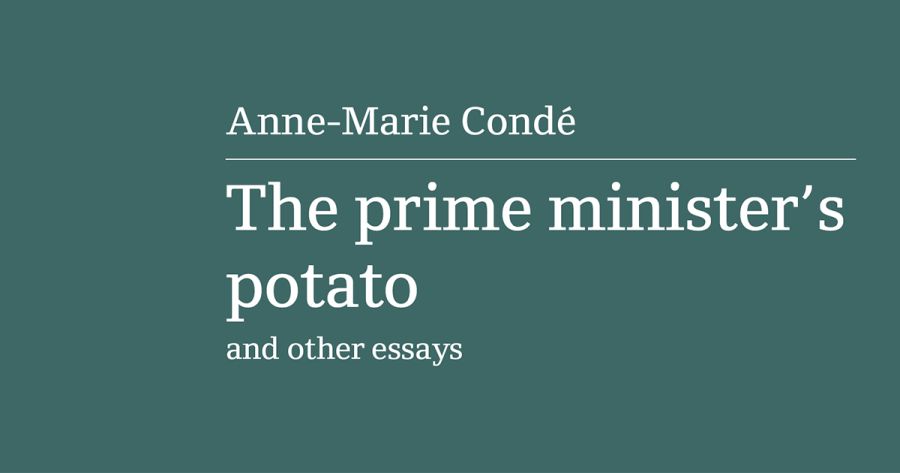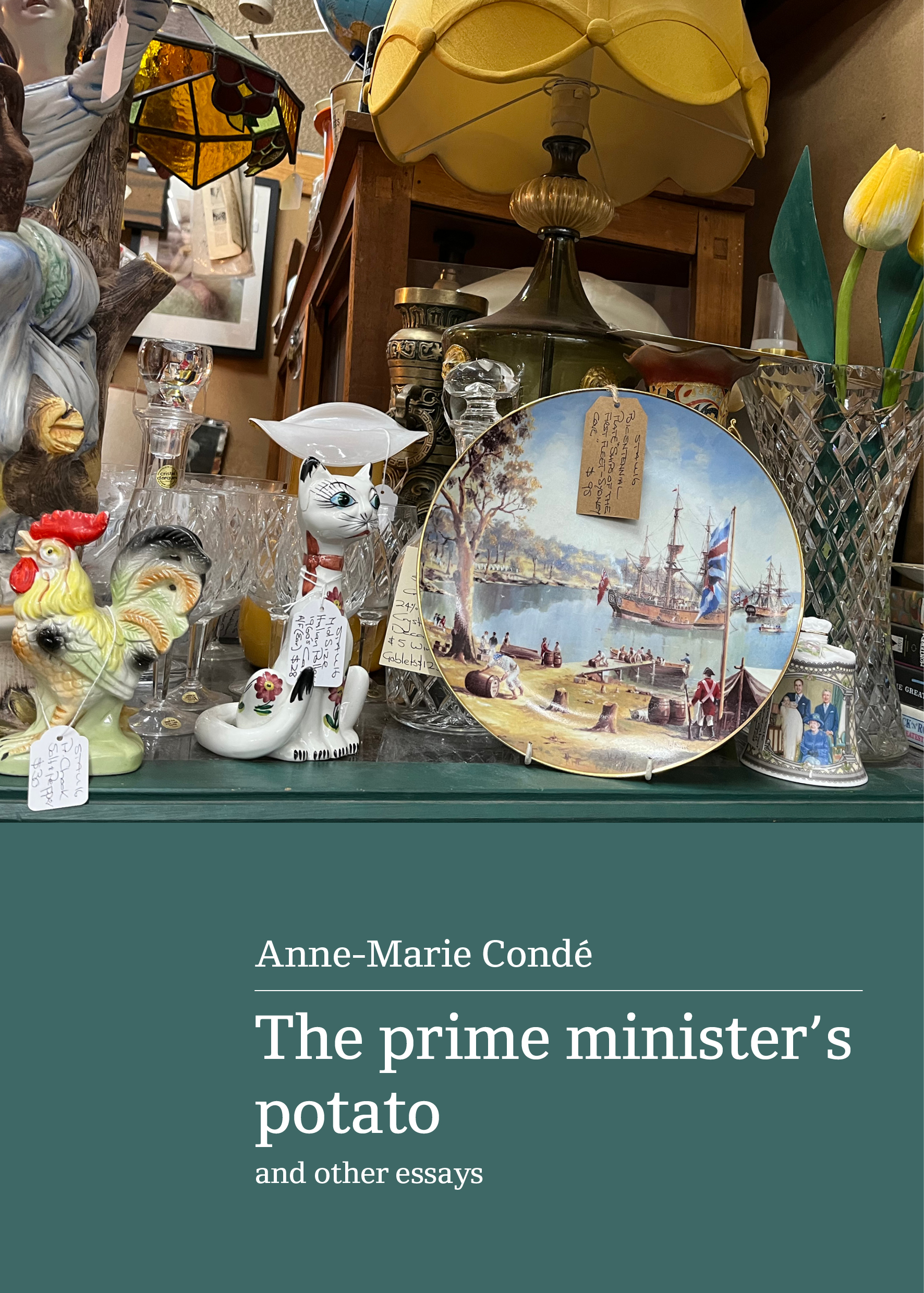
- Free Article: No
- Contents Category: Essay Collection
- Review Article: Yes
- Article Title: Condé’s crystallisations
- Article Subtitle: The roving eye of a curator
- Online Only: No
- Custom Highlight Text:
Tasmania punches above its weight in the literary world, as elsewhere. And not before time: traditionally it always seemed marginal and could be left off the map of Australia on logos. A change came about fifty years ago, with the emergence of the Greens and the campaigns to save Lake Pedder and the Franklin River. Now, what with quality food and wines and MONA and MOFO – plus something of a southward migration given climate change – Tasmania has become trendy. But it remains a place where the past lingers.
- Book 1 Title: The Prime Minister’s Potato
- Book 1 Subtitle: And other essays
- Book 1 Biblio: Upswell $29.99 pb, 198 pp
- Book 1 Cover Small (400 x 600):

- Book 1 Cover (800 x 1200):

- Book 1 Readings Link: https://www.readings.com.au/product/9781763733138/the-prime-ministers-potato-and-other-essays--anne-marie-conde--2025--9781763733138#rac:jokjjzr6ly9m
Anne-Marie Condé is an archivist and curator living in Canberra. And it is to Tasmania that she constantly returns. This book of collected essays demonstrates how Condé’s vision broadens out from the display case. She loves to place an object – be it a telegram, a postcard, or a piece of Bicentennial kitsch – in context, and has the research skills to do it. ‘What catches my attention’, she writes, ‘are stories and memories outside the museum walls.’ She owns to a ‘desire to gather up what is lost, mend what is broken, and bear witness to the uniqueness of every human experience … There is as much history to be discovered in a row of trees or a row of old shops as in a row of books.’
Indeed, in one of those shops Condé happened upon a trove of old postcards, and was struck by the verse printed on one of them. ‘Fancy you thinking of poor little me’, it begins – under the heading ‘Gratitude’. As Condé comments, poor Nellie, who sent it, was probably ‘one of life’s doormats’. Certainly, no card manufacturer would publish such self-deprecating verse today. Cast-off ephemera often yields insights into past mentalities.
This applies not only to small things, but to the ramifications of great ones. Much of the book is taken up with Anzac and commemoration. (Condé points out that when it came to celebrating the centenary of World War I, Germany’s projected spend for each soldier and civilian killed in the war was $2, France’s was $52, the United Kingdom’s was $109 – and Australia’s was $8,889.) From a surviving telegram, she follows the process of official notification of a soldier’s death: telegrams were sent not directly to the family, but to the relevant clergyman, whose melancholy duty it was to deliver it. Condé points out – standing in a small cemetery – attention to individual stories can ‘nibble away’ at grand narratives, ‘proposing new relationships between apparently disparate experiences’.
Among the other pieces in the book is a superb essay on Barry Humphries. While focused on Sandy Stone, Condé has followed Humphries closely enough to have picked up two attacks he made on trans people. She hits on his default mode, provocation, and how – when all else failed – he could, and would, weaponise boredom.
Moving on from the Ednacious one, Condé writes on Roy Bridges, a popular writer of the 1940s and 1950s. This involved Condé returning to the subject of her honours thesis, written when she was rather wary of drawing any conclusions about his sexuality. She now credibly asserts that Bridges was a closeted gay man, who had to settle for a romantic friendship when what he needed was romantic love. Bridges lived in Melbourne for a time but returned to rural Tasmania to live with his sister.
Condé is mindful of how much Tasmania disapproved of homosexuality, pointing out that it was the last place in the British Empire to hang a man for sodomy (in 1867), and the last state in Australia to legalise homosexual relations, in 1997. Indeed, the prejudice ran deeper than in most places, for it was associated with the convict taint. Convict homosexuality had been of some concern to the authorities, all the way up to William Gladstone, later British prime minister. Prejudices have a way of lingering, long after the cause of intensification has faded away.
One of the best essays is a reconstruction of the life of Arthur Stace, Sydney’s ‘Eternity’ man. Often dismissed as a madman, he pointedly dressed in a suit, hat, and tie as he knelt down on pavements, and in a copperplate hand repeatedly wrote that one, resonant word. For him it was both a caution and a statement of faith. As Condé demonstrates, until his Christian conversion in 1930, Stace had been shaped by catastrophic family circumstances – extending to a poisoning as well as rape. After indifferent foster care, for a while he became a petty criminal. The church, Condé surmises, gave him the only community he had known.
Just before the book’s close, Condé turns to Secheron, a fine old home in Battery Point, Hobart. For her personally, the house represents loss – Condé was taken from there as an infant, but family talk kept it very much alive – and a haunting presence. Perhaps that helps to explain how as a girl Condé was fascinated by the shards of pottery that she found in the schoolyard, and began to feel the pull of the past. Later she would learn that the elegant Georgian house was built by Surveyor-General George Frankland. There he hosted a dinner for the visiting Charles Darwin, who so warmed to Tasmania that late in life he would say that he had indulged a fantasy of emigrating there. For Condé, the Darwin connection came to serve as validation of her quest to explore the wider world.
This is a wonderful book, tightly focused and nicely written. The essays are exploratory, working from the object outward, seeking context. True, sometimes Condé moves beyond the evidence available to clearly differentiated speculation. (‘Here’s a thought’, she parenthesises a couple of times.) But in addition to the manuscript sources, historical databases have rarely been used so effectively.


Comments powered by CComment